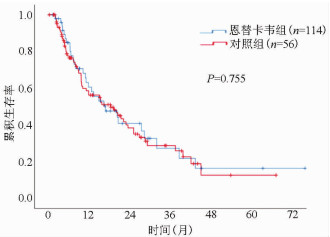| [1] |
BRAY F, FERLAY J, SOERJOMATARAM I, et al. Global cancer statistics 2018: GLOBOCAN estimates of incidence and mortality worldwide for 36 cancers in 185 countries[J]. CA Cancer J Clin, 2018, 68(6): 394-424. DOI: 10.3322/caac.21492 |
| [2] |
VILLANUEVA A. Hepatocellular carcinoma[J]. N Engl J Med, 2019, 380(15): 1450-1462. DOI: 10.1056/NEJMra1713263 |
| [3] |
VERSLYPE C, ROSMORDUC O, ROUGIER P, et al. Hepatocellular carcinoma: ESMO-ESDO Clinical Practice Guidelines for diagnosis, treatment and follow-up[J]. Ann Oncol, 2012, 23(Suppl 7): vii41-48. http://www.biomedcentral.com/pubmed/22997452 |
| [4] |
OMATA M, CHENG AL, KOKUDO N, et al. Asia-Pacific clinical practice guidelines on the management of hepatocellular carcinoma: A 2017 update[J]. Hepatol Int, 2017, 11(4): 317-370. DOI: 10.1007/s12072-017-9799-9 |
| [5] |
WANG K, JIANG G, JIA Z, et al. Effects of transarterial chemoembolization combined with antiviral therapy on HBV reactivation and liver function in HBV-related hepatocellular carcinoma patients with HBV-DNA negative[J]. Medicine (Baltimore), 2018, 97(22): e10940. DOI: 10.1097/MD.0000000000010940 |
| [6] |
LIN XJ, LAO XM, SHI M, et al. Changes of HBV DNA after chemoembolization for hepatocellular carcinoma and the efficacy of antiviral treatment[J]. Dig Dis Sci, 2016, 61(9): 2465-2476. DOI: 10.1007/s10620-016-4167-5 |
| [7] |
PIETRO L, KOSH A THOMAS B, et al. EASL 2017 Clinical Practice Guidelines on the management of hepatitis B virus infection[J]. J Hepatol, 2017, 67(2): 370-398. DOI: 10.1016/j.jhep.2017.03.021 |
| [8] |
Chinese Society of Infectious Diseases, Chinese Medical Association; Chinese Society of Hepatology, Chinese Medical Association. Guidelines for the prevention and treatment of chronic hepatitis B (version 2019)[J]. J Clin Hepatol, 2019, 35(12): 2648-2669. (in Chinese) DOI: 10.3969/j.issn.1001-5256.2019.12.007 |
| [9] |
LIU WP, XIAO XB, XUE M, et al. Prophylactic use of entecavir for lymphoma patients with past hepatitis B virus infection: A randomized controlled trial[J]. Clin Lymphoma Myeloma Leuk, 2019, 19(2): 103-108. DOI: 10.1016/j.clml.2018.11.008 |
| [10] |
National Comprehensive Cancer Network.NCCN clinical practice guidelines in oncology: Hepatobiliary cancers (2012)[EB/OL]. https://www.nccn.org/. |
| [11] |
YEO W, JOHNSON PJ. Diagnosis, prevention and management of hepatitis B virus reactivation during anticancer therapy[J]. Hepatology, 2006, 43(2): 209-220. DOI: 10.1002/hep.21051/full |
| [12] |
LAO XM, LUO G, YE LT, et al. Effects of antiviral therapy on hepatitis B virus reactivation and liver function after resection or chemoembolization for hepatocellular carcinoma[J]. Liver Int, 2013, 33(4): 595-604. DOI: 10.1111/liv.12112 |
| [13] |
YU LH, LI N, SHI J, et al. Does anti-HBV therapy benefit the prognosis of HBV-related hepatocellular carcinoma following hepatectomy?[J]. Ann Surg Oncol, 2014, 21(3): 1010-1015. DOI: 10.1245/s10434-013-3320-z |
| [14] |
KUSUMOTO S, ARCAINI L, HONG X, et al. Risk of HBV reactivation in patients with B-cell lymphomas receiving obinutuzumab or rituximab immunochemotherapy[J]. Blood, 2019, 133(2): 137-146. DOI: 10.1182/blood-2018-04-848044 |
| [15] |
PARK JW, PARK KW, CHO SH, et al. Risk of hepatitis B exacerbation is low after transcatheter arterial chemoembolization therapy for patients with HBV-related hepatocellular carcinoma: Report of a prospective study[J]. Am J Gastroenterol, 2005, 100(10): 2194-2200. DOI: 10.1111/j.1572-0241.2005.00232.x |
| [16] |
LIAO Y, WANG B, HUANG ZL, et al. Increased circulating Th17 cells after transarterial chemoembolization correlate with improved survival in stage Ⅲ hepatocellular carcinoma: A prospective study[J]. PLoS One, 2013, 8(4): e60444. DOI: 10.1371/journal.pone.0060444 |
| [17] |
LAO XM, LUO G, YE LT, et al. Effects of antiviral therapy on hepatitis B virus reactivation and liver function after resection or chemoembolization for hepatocellular carcinoma[J]. Liver Int, 2013, 33(4): 595-604. DOI: 10.1111/liv.12112 |
| [18] |
JIANG E, SHANGGUAN AJ, CHEN S, et al. The progress and prospects of routine prophylactic antiviral treatment in hepatitis B-related hepatocellular carcinoma[J]. Cancer Lett, 2016, 379(2): 262-267. DOI: 10.1016/j.canlet.2015.07.016 |
| [19] |
HEIMBACH JK, KULIK LM, FINN RS, et al, AASLD guidelines for the treatment of hepatocellular carcinoma[J]. Hepatology, 2018, 67(1): 358-380. DOI: 10.1002/hep.29086 |








 DownLoad:
DownLoad: